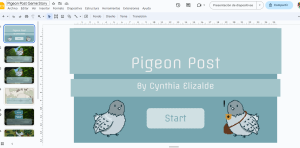I’m not sure if we were supposed to post our final project draft, but I’ll post it just in case. I will be using my Hypermedia project: Twine Link
I haven’t edited it because I’m planning on making it a Google slides presentation story with choices and images. I felt like I would have a lot of freedom using google slides to have a “game” feeling to my story. I’m not used to Twine, which made it difficult for me to do more things in my Hypermedia project.
I’m planning on drawing my characters and settings and I recently started doing these slide, so I don’t have many right now. I’ll share a screenshot of my google slides so that you can see what is what I want to do with my project.
I might change some parts of my story, but I’m still not sure what I want to change or add.



















